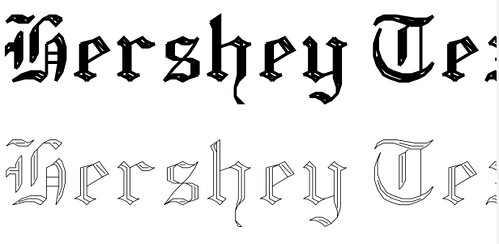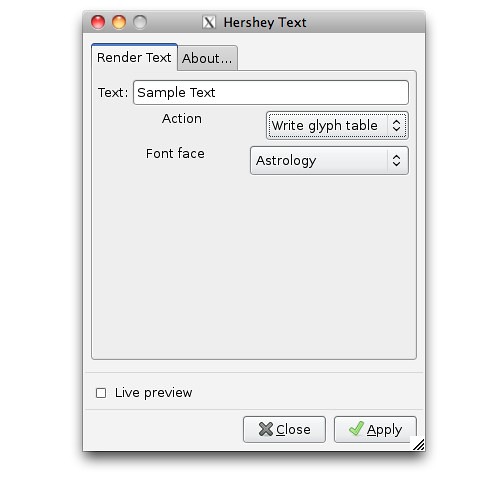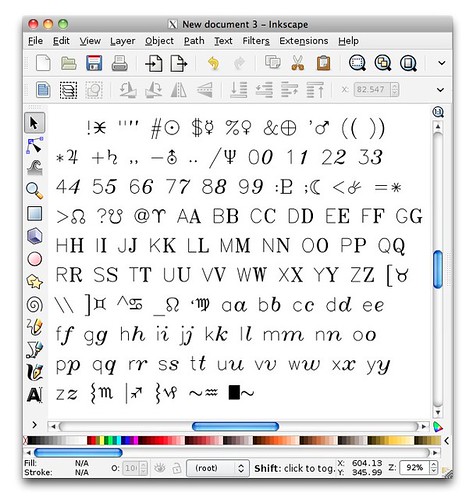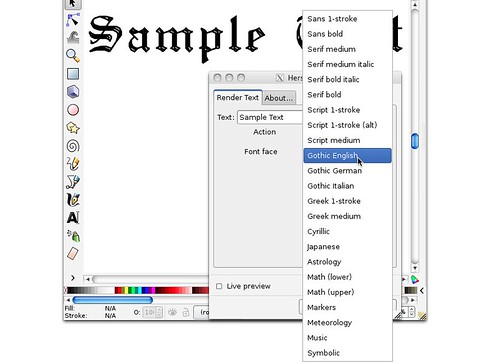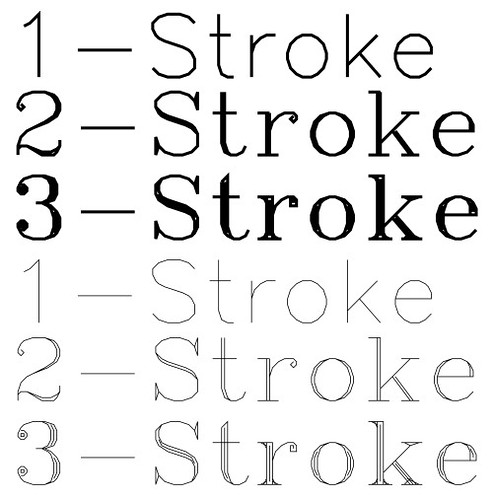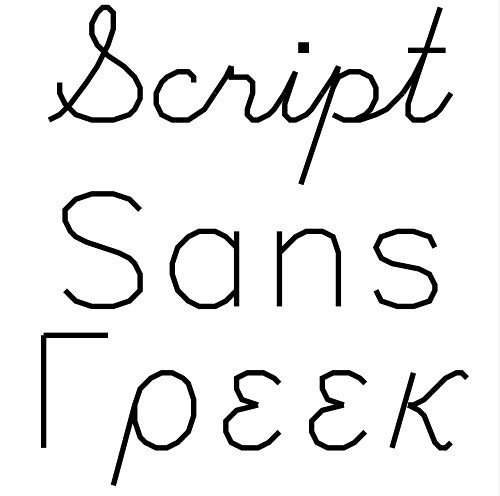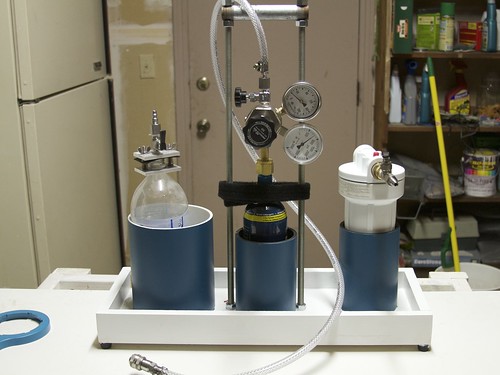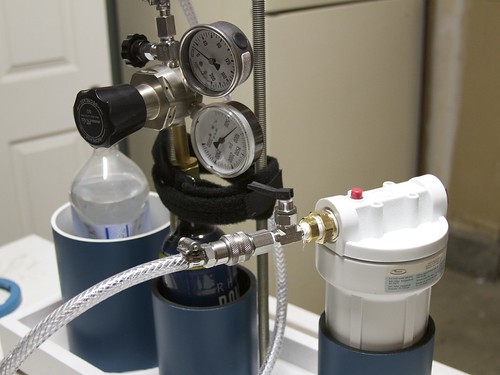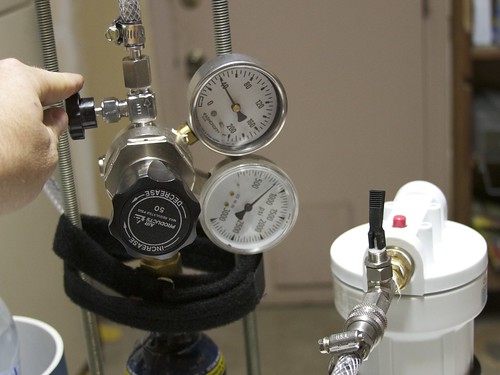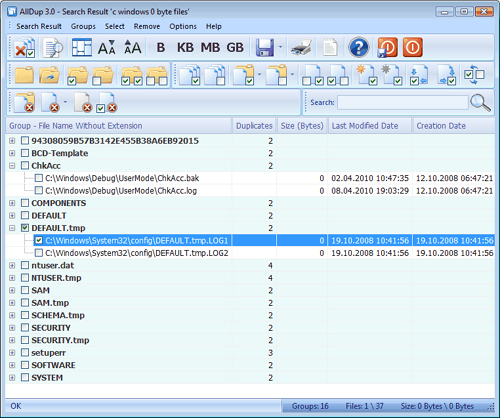
2011年2月28日星期一
Eight Great Tools Windows Users Would Never Want To Miss

Six Useful Google Code Labs Products For People Who Develop Websites

free virus protection spyware removers security tool virus removal
Blekko and Stack Overflow
Suggested Edits and Edit Review
Hershey Text: An Inkscape extension for engraving fonts
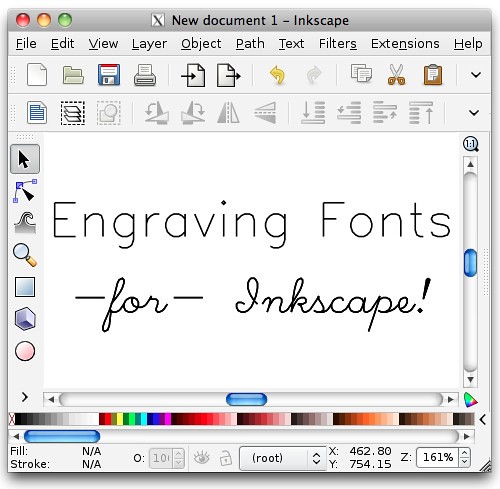
Hershey Text is an Inkscape extension that can render a line of text in one of several stroke-based "engraving" fonts. This extension solves a persistent problem, and one which we have come across in many different contexts: How to easily create simple and readable vector representations of text.
Quick start: Download the latest version of this extension here, and install it like a regular Inkscape extension. Much more information follows.
Huh? What's this all about? Why are you doing this?
It's kind of a long story. But it goes to the heart of who we are and what we're doing.
Neither the problem nor the fundamental solution are new. Creating simple representations of text was an important problem in early computer graphics, for both vector displays and pen plotters. Good solutions-- sets of "engraving" fonts --were developed. But then along came "outline" fonts, dot matrix monitors, high-resolution printers and personal computers. And that was that.
Thirty years later, low-cost and easily available computer-controlled manufacturing tools have created an exciting realm for exploration that's even open to most hobbyists: Laser engravers, 3D printers, CNC routers, vinyl cutters, embroidery machines, (yes) pen plotters. If you design for any of these on a regular basis, you're likely to come across a case where you'd like to efficiently create some readable text with your tool, and "engraving" fonts are often the best choice. For this very reason, many professional-level CAD tools include some form of engraving font.
The trouble is, many CAD pagages and most illustration packages (including our favorite, Inkscape) do not come with engraving font support, because it's such a specialized requirement. We'd like to fix that.
Outline fonts versus Engraving fonts
We've mentioned outline fonts and engraving fonts, but let's clear on these. Most modern font systems (truetype, postscript, opentype, etc.) are examples of outline fonts. In these, the font file describes a filled vector shape. That is to say, the visible part of a character in an outline font is the area enclosed by the shape. Fonts like these are appropriate for use in laser printers or other high-resolution devices. By contrast, an engraving font (sometimes called a "stroke" font) is one where each visible character is defined by the stroke itself, not the area enclosed by it. Fonts like these are appropriate for pen plotters, machine tools, and other circumstances where the pen width itself is significant.
Here are examples of text written in an outline font versus written in engraving font:
In the upper box, both lines of text are drawn with a solid black fill, and no stroke (outline). The outline font is legible; it looks as it is intended.
The engraving font is basically illegible, since the enclosed area is not meaningful. In the lower box, both lines of text are drawn without any color fill, but instead with a solid black stroke. This renders the engraving text correctly.
Now, there's a time and place for both types of font face.
Outline fonts are perfect for use with high-resolution raster imaging devices, like LCD screens and laser printers. In these cases there's no significant penalty for filling in large regions.
But, if you use any of the physical fabrication methods that we've already mentioned, then there is usually a significant time cost to filling in large regions. For example with a pen plotter, it's much faster to draw the outline of the engraving font than to raster back and forth to fill in the entire outline font area. The higher the pen resolution (the smaller the tip), the slower it will be. The same goes for text areas cut with a milling cutter on a CNC machine, certain types of laser-engraving, embroidery machines, and so on.
A second reason (besides speed) to use engraving fonts with physical fabrication is that the tool size is often significant. The tool size could be the pen width (for a plotter), the cutter width for a milling machine, or the thread width for embroidery. You certainly can use an outline font and just trace its outline, but that can create legibility issues, especially if your tool is wide. By contrast, engraving fonts rely on the tool width to create the legibility. In the example above (shown with and without a realistic thick pen stroke), it is the pen width that creates the intended character.
Other examples where we've come across good uses for engraving fonts include production laser engraving (where a single-stroke font lead to a huge speedup), printed circuit board design, where the minimum silkscreen and copper widths led to better looking graphics when we used engraving fonts, extrusion-based 2D and 3D printers (including cake decorators and MakerBot), and genuine pen plotting with 2D machines and the EggBot.
Getting and Installing the extension
Download the latest version of this extension here. You will need to have a recent copy* of Inkscape installed as well.
The easiest way to install them is to simply copy the three files from the ZIP file into your Inkscape extensions directory. Depending on your operating system, this file is usually located in one of the following directories:
Windows: C:Program Files>Inkscape>share>extensions
Linux: "/usr/share/inkscape/extensions"
OS X: "/Applications/Inkscape.app/Contents/Resources/extensions"
Once you copy the files into that folder, restart Inkscape.
*Special note for MacOS 10.6 users: Use Inkscape 0.48.1 or newer, or install the Eggbot extensions for Inkscape.
If the Hershey Text extension is installed correctly, it will show up in the "Render" submenu of the Extensions menu in Inkscape.
Using the extension: Rendering text
To create a line of text, type your text into the box. Make sure that "Typeset that text" is selected as the "action," select your font face, and click "apply."
If all goes well, the line of text that you've entered will appear on your drawing. The line of text shows up as a group of path objects. The text is rendered as a drawing, not as editable text. You can resize and move the text object as you see fit. You can also use all of the usual path manipulation tools to edit the shapes within Inkscape.
Using the extension: Glyph tables
The fonts included with the extension are a classic set of Hershey fonts, spanning normal keyboard characters. While many of the characters are straightforward to locate, others-- particularly obscure symbols -- don't have a clear keyboard mapping. The extension has a mode to create a glyph chart, to help you locate and type interesting symbols.
To use the glyph table, make sure that "Write glyph table" is selected as the "action," select your font face, and click "apply."
Here's a typical result. The table contains a pair of characters for each symbol in the font face. The left symbol is the "standard" keyboard character-- as rendered in the single-stroke sans font -- and the right symbol is the corresponding glyph from the selected font face.
Using the extension: Fonts and name conventions
The extension contains a selection of more than 20 font faces.
We have modernized several of the font names, to reflect conventions developed in recent years, and strictly for reasons of clarity. Instead of "Roman Simplex" and "Roman Complex", we've used terms like "Sans," and "Serif." Likewise, rather than "Simplex," "Duplex," and "Triplex," we've used the terms "1-stroke," "medium," and "bold" -- reflecting one, two, or three-stroke wide characters.
Single-stroke fonts have but a single pass through each major section of each character. The wider fonts fill in as needed to create the correct medium or bold appearance.
Three of the font faces are true single-stroke fonts that are extremely efficient for machining operations:
Those are, "Sans 1-stroke," "Script 1-stroke," and "Greek 1-stroke."
Smoothing the characters
You may notice that the drawing above seems a bit "jerky." that's because these fonts are made of straight line segments. And, this is actually the full resolution of the original font design.
You may find it convenient to simplify the paths to create a smother shape.
To do so, select the Hershey Text object that you wish to smooth, and select Path>Simplify from the menu.
Having done so, here is the result: Smoother text.
About Hershey and his fonts
The engraving typefaces built into our Inkscape extension have been around for quite some time. They are a subset of those designed by Dr. A. V. Hershey while working for the US government in the 1960's, and then widely disseminated by the US National Bureau of Standards in the 1970's, in "Tables of Coordinates for Hershey's Repertory of Occidental Type Fonts and Graphic Symbols."
They are now generally considered to be in the public domain.
The complete Hershey library contains thousands of characters in many languages. Each symbol is composed solely of straight lines, and is defined individually through a "moveto/lineto" kind script. You can read more about the Hershey fonts here and here.
Special thanks to Marty McGuire for motivating this with his SVG Hershey Font collection and to Dan Newman for additional test and symbol verification.
Best Free Online Spell Check Websites
Post from:
Best Free Online Spell Check Websites
remote computer repair on site pc repair computer hardware repair
Customizing what is an e-mail alert on Aurora and Vail
[This post comes courtesy of Adrian Maziak, our System Health PM]
Windows Server ?Aurora? is currently in Beta (You can download it from Connect, or read about the beta announcement). You?ve had it for a few months, and have probably run out of things to try on this beta. Well, I wanted to get you back involved with some customization goodies for the health and monitoring alerts that are built both into the Aurora and the Vail products that will carry into the final release.
In previous versions of Home Server, Monitoring could only be done without an add-in in the local console, or from the system tray icon on a local client. You needed something like @WHSTweet to get the alerts off the box (which by the way was a wicked application, I use it for my V1), or perhaps another add-in that I?m not aware of. Also, in previous versions of Small Business Server, there was an Exchange mail server locally to send the alert. But in Aurora there is no exchange server, that?s saved for SBS7.
With Aurora or Vail we provide the ability to insert a ?SmartHost? email server that you can send mail through. This can be an email server that lives out on the Internet that you have access to, or the one at your ISP that you simply have access to simply by being part of their network.

However, not all alerts will generate e-mail. The health team took a hard look at all the alerts and have made a call on which ones might be critical for the admin to know immediately, and which ones that can wait until the admin is on the network. But while we optimize this for certain scenarios, we may have missed yours. This is where customization comes in.
Each health alert is defined in a health definition file. These definition files are stored in C:\Program Files\Windows Server\Bin\FeatureDefinitions\Microsoft Base\definition.xml.config.
For example, if you were to scroll down in this file to the ?AutoStartServicesVistaWin7Client? for the alert about auto started services on clients that aren?t running. This doesn?t alert by default via email, but if you wanted it to, you can add a line to the XML file <Escalate>true</Escalate>.
<HealthDefinitionConfiguration Name="AutoStartServicesVistaWin7Client">
<Configurations>
<Enable>true</Enable>
<Escalate>true</Escalate>
</Configurations>
<Arguments>
<Argument Name="Description">don?t touch this stuff</Argument>
</Arguments>
</HealthDefinitionConfiguration>
Likewise, if you are getting an alert via email that you really don?t care about, then simply open up the definition xml file and remove the <Escalate> line.
Important Tip: Make sure you back-up the definition.xml.config file before you change it. You never know when you?re going to need to revert back to the default version!
Some Known SmartHosts
| SMTP Server | SSL? | Auth? | Port | Logon Information |
| smtp.live.com | Yes | Yes | 587 | Full LiveID username & Password |
| smtp.comcast.net | Yes | No | 587 | Must be in Comcast?s Network |
| smtp.gmail.com | Yes | Yes | 587 | Full GMail username & password |
| smtp.mail.yahoo.com | No | Yes | 25 | Email Name and password |
*Subject to change without notice

Example using the Live Smart Host
GigaOM: Is Feature vs. Performance the New Cloud Battle Line?
How to set the Default Printer for All Users in your Small Business Server 2011 Standard or Essentials Network
One of the biggest pains in a small business is setting up the default printer that everyone needs to use. With these high powered printers that can handle pages per second and are often shared between a very high number of small business employees, if not all, setting the default printer can be a tedious task.
Before you can start, you need to make sure that the clients understand the new policy. Windows 7 and higher have the GPO extensions needed to understand this policy, but they will need to be installed on Windows XP or Windows Vista clients. If you are running SBS 2011 Standard, you can create a "Feature Pack? inside WSUS server and deploy it to all your clients without visiting them. If you?re running SBS 2011 Essentials, you?ll have to manually install it on each client computer.
Next, we should get the Group Policy in place. The Group Policy will apply to all users as they log in to change the default printer, should we set it up correctly. To do this we?ll first create a Group Policy Object to work with. It?s always good practice to create a new Policy that you can enable/disable per item you wish (although keep in mind that the more policies you add, the slower it takes clients to apply them all). Here is how to create the default policy:
- Click Start, Administrative Tools, and then Group Policy Management.
- Expand Forest: <domain.local>, then Domains, and then <domain>.local
- Right-click on domain.local and click Create a GPO in this domain and Link it here
- Give it a friendly name, I called mine Default Printer Policy, leave the starter GPO to (None)
Now we have a policy to work with. Next up we have to make this policy do something. Right now it doesn?t. As a test, I like to make sure it works for one user first, so let?s find a guinea pig and go from there:
- With the new Default Printer Policy selected, remove Authenticated Users from the Security filtering and place in the guinea pig user. Select Authenticated Users, and click Remove.
- Click the Add? button, type in the user?s alias and click OK.
This ensures that the policy only applies to the one user. Now let?s set up that default printer within the GPO:
- Right-click on the Default Printer Policy GPO and chose Edit?
- The GP Management editor opens, expand User Configuration, Preferences, Control Panel Settings, and select Printers:
- Right click on Printers, and choose New? and then Shared Printer.
- Under the Action drop down, make sure it says Create
- Under the Share Path: put the path to the shared network printer
- If you want it to be the default printer, tick the Set this printer as the default printer. In some cases, few people in the business have private/personal printers, you can exclude these if there is a local printer attached by checking the next box
This of course implies that the printer is installed on each client computer you want to use it on. What I did was install the printer and share it off the server. This had the x64 drivers on the server for handing out to the clients on the network. So the MultiPoint 2011 server on my network automatically installed and configured the printer as the default one. However, the 32 bit Windows 7 clients did not. In order to do this, I had to add the x86 drivers to the printer. Do do this:
- Right-Click on the printer that?s installed on the server and choose Printer Properties
- On the Sharing tab, choose Change Sharing Options and then click Additional Drivers
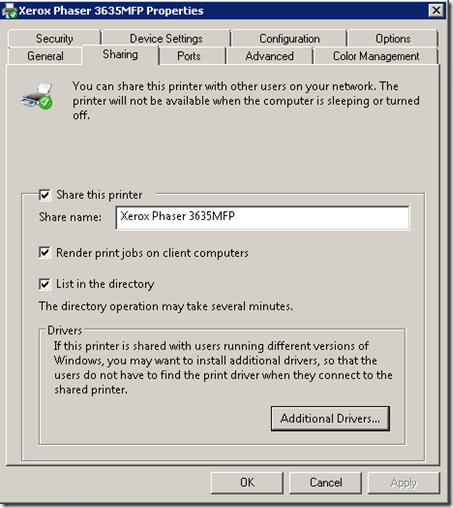
- Select the x86 check box and click OK.. To install these you?ll need both the 32-bit drivers for your printer (usually downloaded or on a DVD), and a 32-bit disk of the operating system. (If you have any Itanium hardware, you?ll have to repeat for this as well)
Once this is finished, the clients both x64 and x86 will install the drivers straight from the server instead of Windows Update. Which is much faster!
There are additional steps you can take to make parts of your network choose different printers as their defaults etc. For those I?m going to send you directly to my two sources of information
The Windows Server Administration blog provided most of the information, with their blog post available here.
The Group Policy Center blog provided some reference info, with their blog here.
Linxter to Present at Microsoft 2011 MVP Global Summit
mobile computer repair computer repair rates pc repair company
2011年2月27日星期日
The CO2inator
"Infusing unsuspecting whole fruit with gaseous CO2 in the entire Tri-State Area!"
In an effort to make fruit fun for the kids, I built a carbon dioxide injector from parts in my garage with the purpose of carbonating whole fruit! With a common house water filter housing, a 16 Oz paintball CO2 canister, an old gas regulator, and some miscellaneous valves and fittings, I was able to bring this fizz fruit apparatus to life, and the kids love the results.
The principle
Carbon dioxide dissolves well in water, hence the reason you find it as the source of fizz in all your favorite soda drinks. When you open your soda and let it sit out on the counter you will find that after some period of time the soda loses its fizz and becomes "flat." The rate at which the drink loses its fizz depends on pressure, temperature and the surface area of the liquid and the environment. Skipping the thermodynamics lecture, let me just tell you that the process works in reverse as well. To reverse this process, one needs only to have a high pressure CO2 environment, a medium to infuse (i.e., the fruit) and enough time to let the gas diffuse across the fruit skin and dissolve into the water inside. Refrigerating the fruit helps tremendously in the process as well.
Parts list
- 16 Oz paintball cylinder (or a more proper CO2 tank if you happen to have one)
- Gas Regulator
- Household water filter housing
- Some hose
- Toggle or ball valve
- Miscellaneous fittings to hook it all up
- Fruit
This type of water filter housing is designed to withstand water pressures in excess of 100 psi, and it comes with two ports and an o-ring seal. These can be bought for about ten dollars at Lowes or Home Depot. Its ports are standard 3/4-inch type. Use Teflon tape (plumbers tape) on all the threads. Thread in a plug on one side and a valve on the other. I used a toggle valve with a quick disconnect to make everything easier. The hose can by any standard type rated for at least 100 psi. Small bundles are available in the plumbing section of your hardware store.
For gas handling I used an old single stage regulator. These can be quite expensive new but often times you can find deals at garage sales or in surplus stores. You don't need anything fancy, just something to step down the pressure to something manageable-- well below 100 psi. My CO2 source is a standard-issue paintball cylinder.
Procedure:
- Pre-chill the fruit in the refrigerator. Get it nice and cold. My favorites are grapes, oranges and blueberries. However, just about any fruit with a large water content will work.
- Open the house water filter by unscrewing the lid. Place your cold fruit inside.
- Connect the CO2 tank to your water filter housing. This is where the quick disconnects come in handy.
- Adjust the regulator output to about 40-60 psi, the higher the better but make sure all your connections are extra tight and sealed or "it might get dangerous." If you think you have a leak somewhere, you can apply some soapy water where you think the leak is and look for bubbles. If you see bubble just tighten until they stop forming.
- Start pressurizing the house filter by opening the toggle valve. On top of the water filter housing there is a pressure relief button. Depress this while you fill to get some of the residual air out.
- Once pressurized, shut the toggle valve and disconnect the CO2 line. You can store the unit in the fridge or somewhere out of sight.
- Then, you wait. Depending on the fruit, temperature, and pressure, carbonation should occur between 20-60 minutes. If you go too long at too high a pressure the skin of the fruit can burst and it will be a big mess, if you go too short and at too low of a pressure, the results will be unimpressive. Experiment with your fruit, pressure, and duration until it suits your tastes.
- Open the toggle valve to release the pressurized gas then unscrew the lid to the housing and enjoy your newly carbonated fruit.
And of course, the kids love the "poppy fizz" inside the fizzy fruit.
free virus protection spyware removers security tool virus removal
Engine Yard Cloud Out Loud S01E12: Mike Wolfe
This week on Cloud Out Loud, our own Marcy Campbell interviews her longtime friend, serial entrepreneur Mike Wolfe. Mike’s disruptive new startup, ccLoop, is set to revolutionize the way you manage your email. Check out TechCrunch’s recent article to learn more about Mike’s new business (still in stealth mode).
We love to give entrepreneurs the opportunity to talk about their business philosophies. We’ve heard a lot of interesting theories about entrepreneurship, but Mike’s characterization of it as an innate compulsion is particularly interesting. Seemingly, some people are just born to hop from startup to startup sowing the seeds of success.
Mike is the quintessential modern businessman–a big-picture guy who loves to solve problems (and who knows how to navigate Silicon Valley). For all you would-be CEO’s out there, Mike’s advice is indispensable. Check it out now!
repair computer computer repair prices computer repair service
Webhosting.uk.com Launches Cloud Based SharePoint VPS
security tool virus removal free spyware removal software free virus scan and removal
Microsoft Open XML embarrassment: spaces go missing between words
Microsoft?s controversial Office Open XML format, now officially called just Open XML*, has an embarrassing bug in its Office 2010 and/or Office 2007 implementation, as reported by Dennis O?Reilly on Cnet.
In a nutshell: if you save a document from Word 2010 using the default .docx format, and send it to a user with
...continue reading Microsoft Open XML embarrassment: spaces go missing between words
Related posts:Our first Aurora add-in, which also works on Vail
Looks like our first Aurora add-in has shown its head! the AWIECO RemoteLauncher. If you want to try add-ins, then go ahead and try this one out.
The AWIECO RemoteLauncher add-in for Small Business Server "Aurora" and Windows Home Server "Vail" Beta Refresh is a free and useful add-in, which gives you more administrative possibilities to manage your SBS or WHS remotely. With this add-in you have access to predefined System Tools like
- Windows Explorer
- Command line
- Event Viewer
- Services
- Control Panel
- Computer Manager
- Device Manager
- Registry Editor
- Task Manager
Stack Apps and Scripts
Share a Word 2010 Document Simultaneously with Multiple Users on Windows Live Skydrive
Post from:
Share a Word 2010 Document Simultaneously with Multiple Users on Windows Live Skydrive
spyware removers security tool virus removal free spyware removal software
The 4313 has landed.
 One of our all-time favorite chips is the ATtiny2313. It's a little 20-pin AVR microcontroller that we've used in dozens of projects, including our high tech holiday decorations, some of our coolest pumpkins, our (digital) Larson Scanner, and some wacky papercraft-- to name a few. It's one of those few chips that we used often enough to justify a custom breakout board. But... if there's one thing that the '2313 is short on, it's memory. With 2 kB of flash (program) memory and 128 bytes of RAM, it's perfect for tiny single-purpose projects. But, it's oh-so-easy to run up against that memory limit. And, that's why we were so excited when Atmel began to announce their then-forthcoming ATtiny4313 in late 2009. Unfortunately, it's often a long delay between when a chip is announced and when it's actually available through distribution. Sample quantities have been floating around for half a year or so, but-- and finally-- a big box showed up in the mail, and so here they are.
One of our all-time favorite chips is the ATtiny2313. It's a little 20-pin AVR microcontroller that we've used in dozens of projects, including our high tech holiday decorations, some of our coolest pumpkins, our (digital) Larson Scanner, and some wacky papercraft-- to name a few. It's one of those few chips that we used often enough to justify a custom breakout board. But... if there's one thing that the '2313 is short on, it's memory. With 2 kB of flash (program) memory and 128 bytes of RAM, it's perfect for tiny single-purpose projects. But, it's oh-so-easy to run up against that memory limit. And, that's why we were so excited when Atmel began to announce their then-forthcoming ATtiny4313 in late 2009. Unfortunately, it's often a long delay between when a chip is announced and when it's actually available through distribution. Sample quantities have been floating around for half a year or so, but-- and finally-- a big box showed up in the mail, and so here they are. 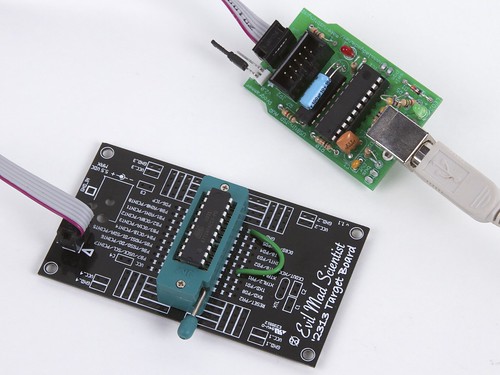 Now, programming it. There are very few changes between the '2313 and '4313. Mainly, it's what you'd expect: memory sizes (Flash, SRAM, EEPROM are all doubled), and the device signature is different. Recent versions of AVR-GCC already support the '4313, and so it's relatively straightforward to recompile an existing program (say, the Larson scanner firmware) to run on the '4313. There are some minor inconsistencies between the "io.h" header files for the two chips, and those inconsistencies can cause compiling to fail. For example, the register name "WDTCSR" (for watchdog control register) works on the '2313, but the '4313 io.h file lists that same register name as "WDTCR." So, if you run into a place where AVR-GCC is confused after switching chips, you might be able to solve the issue by comparing that register name in the "io.h" files for the two chips. Now, for programming the chip with avrdude, things are slightly more complicated. Avrdude does not yet natively support the '4313, but fortunately, you can add the new chip definition by editing the avrdude.conf file on your system. (On my Mac, where I use Crosspack as the AVR toolchain, I found that file at /usr/local/CrossPack-AVR/etc/avrdude.conf ) The '4313 code block can be added right below the '2313 code block, and you can download that code block here (via this mailing list post). So, a couple of steps, but works like a charm.
Now, programming it. There are very few changes between the '2313 and '4313. Mainly, it's what you'd expect: memory sizes (Flash, SRAM, EEPROM are all doubled), and the device signature is different. Recent versions of AVR-GCC already support the '4313, and so it's relatively straightforward to recompile an existing program (say, the Larson scanner firmware) to run on the '4313. There are some minor inconsistencies between the "io.h" header files for the two chips, and those inconsistencies can cause compiling to fail. For example, the register name "WDTCSR" (for watchdog control register) works on the '2313, but the '4313 io.h file lists that same register name as "WDTCR." So, if you run into a place where AVR-GCC is confused after switching chips, you might be able to solve the issue by comparing that register name in the "io.h" files for the two chips. Now, for programming the chip with avrdude, things are slightly more complicated. Avrdude does not yet natively support the '4313, but fortunately, you can add the new chip definition by editing the avrdude.conf file on your system. (On my Mac, where I use Crosspack as the AVR toolchain, I found that file at /usr/local/CrossPack-AVR/etc/avrdude.conf ) The '4313 code block can be added right below the '2313 code block, and you can download that code block here (via this mailing list post). So, a couple of steps, but works like a charm. There aren't a whole lot of these to go around right now, but we've put some of our '4313 chips into little dev kits that you can pick up at our store. Let's see how long they last. ;)
computer repair store free virus protection spyware removers
KnownHost Builds its 11,111th VPS
2011年2月26日星期六
Windows MultiPoint Server 2011 has RTM?d!!!
I?ve mentioned Windows MultiPoint Server 2011 on this blog before, like how well it works with Windows Small Business Server 2011, or how it fits into your small business, and how you can leverage it to simplify your client story. Or if you were at SMBNation Fall 2010 in Las Vegas, or attended the VICE(?) UG talk on SBS 2011 you had ability to actually hear me talk to you about it.
You?ve been patient, you?ve been waiting. And now the wait is over. Windows MultiPoint 2011 Server has RTM?d!!
Product Unit Manager of MultiPoint, Dean Paron, and Director of Marketing Sandrine Skinner announced today that MultiPoint is available (get the eval at the download center)! MSDN and Technet subscribers are expected to receive it in the next week. With the release of RTM, the hand off to the OEM partners happened earlier this month.
Dean Paron, Product Unit Manager, demos Windows MultiPoint Server 2011, source Brandon LeBlanc on the Windows Blog
More Details on the WMS Blog and SBS blog, but here is a snippit of that:
Volume License(VL) customers will be able to download and purchase Windows MultiPoint Server 2011 on March 1, 2011. Broader, public availability through partners will start mid-April 2011.
And by the way the evaluation version available on the Download Center today can be turned into a full production version when you purchase your VL license of Windows MultiPoint Server 2011- so there is no need for re-installation.
We also would like to take this opportunity to thank all of our beta testers for providing feedback and helping us refine and enhance the experience for this new product release.
There has been a lot of discussions around Windows MultiPoint Server 2011 over the last few weeks: it started at the BETT show, the largest tradeshow of Education technology, that took place in London early January where we first had the opportunity to showcase face to face Windows MultiPoint Server 2011 to customers and partners from around the world.
In our previous blogs around the Beta , we mentioned what?s new in Windows MultiPoint Server 2011 versus the previous release of Windows MultiPoint Server (WMS 2010) in terms of features and functionality.
We would like to also mention what?s new in terms of channel availability and SKU availability for Windows MultiPoint Server 2011:
| Standard | Premium | |
| Channel | OEM VL Open Commercial | OEM (pre-install and ROK) OEM Academic VL Open Commercial VL Academic |
| Number of simultaneous connected sessions you can run | 10* | 20* |
| Domain Join capability | Not supported | Supported |
| Hyper-V capability | Not supported | 1+1 licensing model |
*Actual number of connected sessions is based on host computer hardware capacity (CPU, memory, etc.), station hardware configuration (RemoteFX, PCI-E or USB) and usage workloads
As you can see in the table above, we now have 2 editions, Standard and Premium which have the same features and functionality except for the ability to join a domain, and ability to run as Hyper-V host or guest, which are only available in the Premium edition. Also the Premium edition is broadly available to customers and resellers through OEM and OEM Academic as well as through Volume Licensing Open Commercial and Academic.
Again VL customers will have access to Windows MultiPoint Server 2011 on the VL download site on March 1, 2011.
Also worth mentioning, we even had our own famous internal Windows 7 blogger, we?re sure you know him already, Brandon LeBlanc, who?s blogging about his experience with Windows MultiPoint Server 2011: check it out here at this link: http://windowsteamblog.com
We?re so excited about this release as in the WMS team we?re super passionate about delivering technology to help our Teachers and Students thrive and providing them with a Windows 7 experience, even as their school?s or campus? IT budgets have been slashed.
Here?s the link to the Download Center for your convenience- Happy Windows MultiPoint Server 2011!!!!
Make Google Searches More Convenient with the DeeperWeb Firefox Add-on
Post from:
Make Google Searches More Convenient with the DeeperWeb Firefox Add-on
Wargaming.net Reveals Details on World of Tanks Data Center in North America
2011年2月25日星期五
Make Google Searches More Convenient with the DeeperWeb Firefox Add-on
Post from:
Make Google Searches More Convenient with the DeeperWeb Firefox Add-on
computer repair prices computer repair service fix computer problems
Guy Haycock discusses the SMB Announcements at WPC 2010
Up on VarVid.tv, Aaron managed to get our Product Planner, Guy Haycock, on camera talking about the announcements of ?Aurora? and ?SBS7?.
Make Live

We're looking forward to today's premier of Make: Live, a new live web show hosted by Becky Stern and Matt Richardson. The show will feature show and tell DIY projects from guest makers and hackers-- and we'll hope to be amongst those guests in an episode later this year.
The first episode is Arduino focused, and features two (more) remarkable friends of ours: Steve Hoefer (of rock-paper-scissor-golve fame) and Collin Cunningham (of Make Video fame). Steve is bringing his Secret Knock Gumball Machine, and Collin will be discussing his MidiVox shield for Arduino.
The show runs live Wednesday January 26th, 9 PM Eastern / 6 PM Pacific, and you can see it at makezine.com/live or on UStream.
(And, if you can't catch it live, they'll be archiving it on their YouTube channel and iTunes podcast. We'll post direct links to those when they're available.)
Update: You can subscribe to the MAKE Podcast in iTunes, download Make: Live episode 01 in its entirety (m4v), or watch clips on YouTube.
The next episode, "Make: Live 02 - The Soldering Episode," runs Wednesday February 9th, at 9 PM Eastern / 6 PM Pacific
free spyware removal software free virus scan and removal spyware remover
Make Google Searches More Convenient with the DeeperWeb Firefox Add-on
Post from:
Make Google Searches More Convenient with the DeeperWeb Firefox Add-on
pc repair shop wholesale computer parts free malware removal
Windows Small Business Server ?7? Released to Public Beta
This morning Microsoft released the Windows Small Business Server ?7? release to Beta. This marks yet another major milestone for the Windows Server Solutions Team, now releasing both the Windows Home Server ?Vail?, and Windows Small Business Server Hybrid Edition ?Aurora? into beta.
SBS 7 marks a major release in the *next* set of all-on-premise solutions. Updates include:
- Base OS is updated to Windows Server 2008 R2
- Exchange is updated to Exchange 2010 SP1
- SharePoint is updated to Microsoft SharePoint Foundation 2010
- Windows Software Update Services is updated
- The new Remote Web Access (RWA) experience is newer (and matches Aurora!)
- Bug fixes
- etc
You can try out the new SBS ?7? beta by pointing your favorite browser to the SBS Connect site, or jump straight to the downloads page. Don?t forget if you need help, or find an issue to give us feedback, or talk about it in the Newsgroups.
More details can be found on the Official SBS blog.
computer repair store free virus protection spyware removers
How to Use Word 2010 WordArt Features
Post from:
How to Use Word 2010 WordArt Features
How to Alphabetize in Word and Excel
Post from:
How to Alphabetize in Word and Excel
Windows Small Business Server ?7? Released to Public Beta
This morning Microsoft released the Windows Small Business Server ?7? release to Beta. This marks yet another major milestone for the Windows Server Solutions Team, now releasing both the Windows Home Server ?Vail?, and Windows Small Business Server Hybrid Edition ?Aurora? into beta.
SBS 7 marks a major release in the *next* set of all-on-premise solutions. Updates include:
- Base OS is updated to Windows Server 2008 R2
- Exchange is updated to Exchange 2010 SP1
- SharePoint is updated to Microsoft SharePoint Foundation 2010
- Windows Software Update Services is updated
- The new Remote Web Access (RWA) experience is newer (and matches Aurora!)
- Bug fixes
- etc
You can try out the new SBS ?7? beta by pointing your favorite browser to the SBS Connect site, or jump straight to the downloads page. Don?t forget if you need help, or find an issue to give us feedback, or talk about it in the Newsgroups.
More details can be found on the Official SBS blog.
Blekko and Stack Overflow
pc repair prices computer repair companies pc repair business
Aurora and SBS7 have a new name! Announcing SBS 2011 Standard & Essentials
This morning over on the Official SBS blog, we announced the names of both Aurora, SBS7 and the Premium add-on. Both products have been hammered on pretty hard in the current beta, having been downloaded more than 9000 times to both partner and consumer community testers. So what are the final names?
Aurora shall be known as Windows Small Business Server 2011 Essentials. This product is perfect as a first server for small businesses, giving them a cost-effective/easy-to-use solution to help protect, organize and access their data. As you already know, this product will connect up to Office365. SBS11 Essentials can be used by up to 25 users and requires no CALs for access to this server (CALs still apply if you add a TS-in-app-sharing server though!). Pricing for SBS11E is still to come, but we expect to release this in the first half of 2011. To learn more about Windows Small Business Server 2011 Essentials, download the datasheet.
SBS7 shall be known as Windows Small Business Server 2011 Standard. This is designed and priced for small businesses with up to 75 users, delivering that familiar SBS 2008 Standard, enterprise class server technology as an affordable all-in-one solution. SBS7 helps protect information with server backups and more on-site features like email, SharePoint, and WSUS. Licensing is consistent with SBS2008 where CALs are required. Estimated costs are at the official SBS blog, but today state ~$1096 with CALs at $72 (all in USD). Again, this will be released in the first half of 2011. To learn more about Windows Small Business Server 2011 Standard, download the datasheet.
I also wanted to announce the Windows Small Business Server 2011 Premium Add-on. This add-on can be applied to both SBS11e or SBS11s and includes access to another copy of Windows Server 2008 R2 Standard and SQL Server 2008 R2 for the small business. The secondary server can be used for many different purposes, including LOB applications, roll-based such as TS-in-app-sharing (with additional CALs), a BDC, virtualization through Hyper-V, etc. Again, estimated costs for this sku are at the official SBS blog. but today state ~$1604 with CALs at approximately $92 (all in USD).
To learn more about the Windows Small Business Server Family, download the family overview brochure.
To download previews of Windows SBS 2011 Standard and Essentials you can visit here.
To read the official SBS blog post, visit here.
Why I plan on using the new Windows Home Server 2011
I?m sure you have heard by now, that the Release Candidate of the new Windows Home Server 2011 is available for download. It?s a huge milestone, and I?m excited for the final RTM sometime the first half of this year!
There has been a lot of negativity around upgrading to the Windows Home Server (version 1) product, to the Windows Home Server 2011 or even using it at all, all due to the Drive Extender removal. I do understand the pain. I do. But I don?t understand why people instantly now hate WHS????
Looking back, we remember that Drive Extender had some initial problems after the v1 release. Some corner case of editing large files that lived on the server, in some rare cases, these large files were corrupt, people wanted to turn Drive Extender off, it scared them. After Power Pack 1 came in to save the day, only then did people start to trust Drive Extender, and yes, they immediately fell in love with it. Easy drive extension with a side benefit of duplicating files on multiple hard drives (?dup ?em if you got ?em!?).
Removing DE was a very tough decision, but I ultimately agree with the decision given what I know.
But without drive extender, is the product not awesome? is your data not safe? This blog post is intended to tell you why I think WHS 2011 is still awesome, and still keeps my data safe. I am a new father (she?s 8 months old at the time of writing this) and I?m a hobbyist photographer. My photos are probably the most important digital thing to me, then my countless hours of work I?ve spent on my documents, then my e-mail, then all that other stuff, like ripped CDs and DVDs, and some HD DVDs.
Let?s start with the ?Just Awesome? stuff? most of this bucket falls into the Remote Web Access site, so from the outside in we go!
Remote Access is just Awesome!
For one, right from the get-go you can customize the RWA about as much as you want:

(This picture can be found on my photoblog here)
Remember, you also still get that free 3rd level web domain and matching trusted web certificate (from GoDaddy.com) on the home server.com domain name. Did I mention free security?
You get remote access to computers behind your network, but this time it?s powered by TS Gateway for Server 2008 R2! Yes, that means you can get dual monitor support, and you can take advantage of better optimization for remote access to your PC and better security using that same web certificate for encryption! Thus no longer using security protocols from 8 years ago.
Remote Silverlight Video Streaming
Yes, no more TwonkyMedia chewing up your processor, a built-in, secure, streaming engine based on Silverlight, with (if you put in a fast enough processor) media transcoding:
I also just *love* the photo slide shows. Sending access to the folks and letting them just watch 1000s of photos via a slide show, priceless:
A Silverlight Music Player that you can make, save and use playlists on. which you can quickly switch music around in. I even use this player in my living room when I have get a get together. People just understand how to use it:
The ability to download or the ability to move files around without having to download. Yes, that?s right, delete, copy, cut and paste things all over the shared folders without actually having to download it.
That?s a pretty powerful remote access story, one you won?t find with add-ins that run this flawlessly on the WHS v1 product? oh wait, I?m not finished, check out my iPhone formatted remote access webpage:
|
| |
And it looks just as good on an Android and Windows Phone 7!
While we?re talking about media, let?s focus on the internal network. With full DLNA 2.0 compatible streaming, you can stream to your XBOX 360, Playstation 3, DLNA capable TV, iPad (with application), Windows 7 PC (or slate!) or any other DLNA compliant device. You can also configure which folders participate in the streaming, simply by adding them to the set of defaults.
If we?re going to talk about handy apps, do you remember that awesome Vista Gadget for WHS v1 by homeserverhacks.com? It was called ShareMaster. Well, now included in WHS 2011, is the Launchpad, which enables you to easily backup your PC, access your Remote Web Access site (without having to know the URL, even if it changes!), Shared folders, and if you?re an admin, the Dashboard. It?s also completely extensible by the SDK, so developers can kick it up a notch and add more functionality:
That?s a whole lot of awesome packed into one box! I want to switch gears now and talk about how WHS 2011 protects my data, and why I think it?s safe. To me, the leading cause of data loss is usually hardware failure, most often then not, it?s a harddrive failure. Although there is the rare instance it can be a natural disaster, which happened to my uncle about this time last year.
Last but not least, is something you can?t see, that excites me the most. The Windows Home Server 2011 SDK (still in beta) is HUGE compared to the v1 product. Moreover, it?s SHARED with both Windows Small Business Server 2011 Essentials, and Windows Storage Server 2008 R2 Essentials. What does that mean? it means that things designed for business, can easily be used in the home (and vice versa). That means lots and lots of add-ins! and high quality ones at that. Nothing like developing for 3 platforms, instead of just one.
Data Protection, Why My Data is Safe on WHS 2011!
Data protection is all about having data on multiple drives. Take a look at RAID configurations. RAID5 is one of the most popular RAID configurations in the small and medium businesses, it?s probably sufficient for a home too, but sometimes it can be challenging to set up. RAID5 is a drive configuration that wastes up to 1 of a set of 3 or more drives to maintain ?parity? bits. These parity bits are used to rebuild data on a drive if it?s lost. The system can run in limited capacity as soon as this drive dies without the end user knowing it. All in all, it?s a sweet system, but loose that 2nd drive before you can rebuild the array, and your data is toast!
What does Windows Home Server 2011 do? It keeps the data you choose on a second hard drive. Yep, the data on all your client computers is automatically backed up nightly to the Home Server. That?s up to 10 PCs safely backed up, every night. So now the data on your clients, is also on your server, two hard drives. There is a delay of 24 hours, but it?s there. Even if you get a Facebook Virus, you can roll back to the day before. This is exactly the same functionality as WHS v1, except it?s faster, and more robust.
What about the data on the server? Server?s hold data, isn?t that data safe? Yes of course it is. You can backup that data to an internal, or better yet, external hard drive! Unlike WHS v1, this has HUGE improvements. First, the backup is automated. Automated backups take the human error factor out, and the backup uses snapshots, so even open files are captured. I think I remembered to backup my WHS v1 about once/month. Now I?m getting 2x/day! And you know what, I choose the defaults because the server on my data doesn?t change that often. You can bump this up to as often as every 30 minutes. That?s your data, on another hard drive, 30 minute window of possible loss, but if I can?t trust a hard drive for 30 minutes, I?ve got problems with all the data that DOES change on my client computers, because that backs up every 24 hours! [And you can?t tell me that the purchase of an external hard drive isn?t worth your data backup, especially you, Mr. 22TB WHS v1! With or Without Drive Extender]
And?. if you want to do RAID, you can do RAID, you can do RAID1, RAID5, or even RAID10! If you want to do cloud backup (which I do because I?m too lazy to take the backup hard drive out of my house), you can do that, as a few providers are building add-ins.
So what did I really loose with Drive Extender being gone?
- In the event of a hard drive failure, all my data isn?t still available until I put in a new hard drive and restore that drive back to its original state, if I didn?t configure RAID.
- I can?t easily extend my storage when I have a disk that?s running out of space.
- I can?t grow my share sizes past the size of all the hard drives in the system
- My server storage responds faster because I?m not using DEMigrate.exe all the time
None of the above actually pertains to data loss. It?s all convenience. It was definitely nice to have in WHS v1, but I don?t think it?s absolutely needed in a server in the home.
Massive Data Collections
Let?s talk about Massive Data Collections quickly. Because WHS v1 made it so easy to grow your data collections, far beyond the size of one disk, without having to worry, ?have I locked myself in to only X amount of data??.
Let?s talk about my photo collection. It?s 80GB right now. That?s still not 1TB. I?m an amateur photographer, one that shoots a lot of photos, with a Canon 5D Mark II (a 21mp camera). I still have tones of space on a single 2TB drive to grow. What if I?m a professional photographer? Well, professional photographers don?t use Windows Home Server, at least I haven?t come across one. A good friend of mine has been interviewing professional photographers for some time, and they work with such large photos, they keep them locally, then archive them, usually via USB. Then if they want to work on them, they just plug them into the computer they are on, and it?s a local picture again. \
Video collections. My Canon 5D Mark II takes 1080p video. I use it a lot, that?s probably what jumped my photo collection from 60-80G in a year? but I?m still within reason. My video collection, is a rip of all my DVDs, and some HD-DVDs, and it?s still only 130GB, that?s still less than 1TB, and I still have all the DVDs in the closet, my music collection is 40GB? still have all the CDs. But I agree these data collections can get quite huge. This is probably the one place folks will actually miss Drive Extender. I couldn?t agree more.
? But maybe it?s time to take a hard look at what data you?re hording on your server. Do you really need to be a digital hoarder and save everything? I mean even Mozy can?t deal with you, as they announced they are killing their unlimited data plan. People save a lot, and it costs money, but do you really need it all? The guys at TechCrunch say ?I assure you that you will never print those 10,000 pictures you have stored in iPhoto. Never. Ever.?.
If you absolutely *must* keep all that data, you should have a plan for it anyways. It?s not like if you store magazines for comic books, you don?t put aside space in a closet for them. With a plan, you can easily map out your storage needs, and growth. In fact, a few people even have growth charts of their storage growth from WHS v1, so you *know* the storage you?re going to need! I also suggest turning on File System Resource Manager and cataloging exactly which data is being used. I bet after a year, you use less than 30% of it.
So bottom line, I stay trim with my data (rule #1 of becoming a better photographer is forcing yourself to throw away 70% of your photos), I feel like Windows Home Server 2011 is the right product for me, for simplified access to my data. Simplified Management of my network, and extremely safe data protection plans. Moreover, because it?s Windows, it just works with other things in my house.
I liked Drive Extender too, but the product isn?t dead, in fact, it?s still awesome!

